[English] 日本語
 Yorodumi
Yorodumi- PDB-2mfj: Solution structure of Blo t 19, a minor dust mite allergen from B... -
+ Open data
Open data
- Basic information
Basic information
| Entry | Database: PDB / ID: 2mfj | ||||||
|---|---|---|---|---|---|---|---|
| Title | Solution structure of Blo t 19, a minor dust mite allergen from Blomia tropicalis | ||||||
 Components Components | Blo t 19 | ||||||
 Keywords Keywords | ALLERGEN / Anti-microbial Protein | ||||||
| Function / homology | Antibacterial factor-related peptide / Antibacterial factor-related peptide superfamily / Nematode antimicrobial peptide / defense response to other organism / Blo t 19 allergen Function and homology information Function and homology information | ||||||
| Biological species |  Blomia tropicalis (arthropod) Blomia tropicalis (arthropod) | ||||||
| Method | SOLUTION NMR / torsion angle dynamics, DGSA-distance geometry simulated annealing | ||||||
| Model details | lowest energy, model1 | ||||||
 Authors Authors | Naik, M.T. / Naik, N. / Huang, T. | ||||||
 Citation Citation |  Journal: To be Published Journal: To be PublishedTitle: Solution structure of Blo 1 19 Authors: Naik, M. / Naik, N. / Kuo, I. / Liao, Y. / Huang, T. | ||||||
| History |
|
- Structure visualization
Structure visualization
| Structure viewer | Molecule:  Molmil Molmil Jmol/JSmol Jmol/JSmol |
|---|
- Downloads & links
Downloads & links
- Download
Download
| PDBx/mmCIF format |  2mfj.cif.gz 2mfj.cif.gz | 363.9 KB | Display |  PDBx/mmCIF format PDBx/mmCIF format |
|---|---|---|---|---|
| PDB format |  pdb2mfj.ent.gz pdb2mfj.ent.gz | 303.8 KB | Display |  PDB format PDB format |
| PDBx/mmJSON format |  2mfj.json.gz 2mfj.json.gz | Tree view |  PDBx/mmJSON format PDBx/mmJSON format | |
| Others |  Other downloads Other downloads |
-Validation report
| Summary document |  2mfj_validation.pdf.gz 2mfj_validation.pdf.gz | 542.3 KB | Display |  wwPDB validaton report wwPDB validaton report |
|---|---|---|---|---|
| Full document |  2mfj_full_validation.pdf.gz 2mfj_full_validation.pdf.gz | 730.6 KB | Display | |
| Data in XML |  2mfj_validation.xml.gz 2mfj_validation.xml.gz | 35.7 KB | Display | |
| Data in CIF |  2mfj_validation.cif.gz 2mfj_validation.cif.gz | 51.6 KB | Display | |
| Arichive directory |  https://data.pdbj.org/pub/pdb/validation_reports/mf/2mfj https://data.pdbj.org/pub/pdb/validation_reports/mf/2mfj ftp://data.pdbj.org/pub/pdb/validation_reports/mf/2mfj ftp://data.pdbj.org/pub/pdb/validation_reports/mf/2mfj | HTTPS FTP |
-Related structure data
| Similar structure data | |
|---|---|
| Other databases |
- Links
Links
- Assembly
Assembly
| Deposited unit | 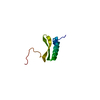
| |||||||||
|---|---|---|---|---|---|---|---|---|---|---|
| 1 |
| |||||||||
| NMR ensembles |
|
- Components
Components
| #1: Protein | Mass: 6945.833 Da / Num. of mol.: 1 Source method: isolated from a genetically manipulated source Source: (gene. exp.)  Blomia tropicalis (arthropod) / Production host: Blomia tropicalis (arthropod) / Production host:  |
|---|---|
| Has protein modification | Y |
| Sequence details | FIRST TWO RESIDUES (GS) ARE EXPRESSION |
-Experimental details
-Experiment
| Experiment | Method: SOLUTION NMR Details: The data from this entry were used to determine structure of Blo t 19. Due to Proline isomerization, Blo t 19 spectrum has degenerate resonances for a stretch of six residues in its C- ...Details: The data from this entry were used to determine structure of Blo t 19. Due to Proline isomerization, Blo t 19 spectrum has degenerate resonances for a stretch of six residues in its C-terminus. These two populations have varying intensities and are unambiguously assigned as major and minor population. Solution structure is calculated for the Major population. | ||||||||||||||||||||||||||||||||||||||||||||||||||||||||||||||||||||||||||||
|---|---|---|---|---|---|---|---|---|---|---|---|---|---|---|---|---|---|---|---|---|---|---|---|---|---|---|---|---|---|---|---|---|---|---|---|---|---|---|---|---|---|---|---|---|---|---|---|---|---|---|---|---|---|---|---|---|---|---|---|---|---|---|---|---|---|---|---|---|---|---|---|---|---|---|---|---|---|
| NMR experiment |
| ||||||||||||||||||||||||||||||||||||||||||||||||||||||||||||||||||||||||||||
| NMR details | Text: NMR data was acquired at 295K using Shigemi NMR tubes. |
- Sample preparation
Sample preparation
| Details |
| ||||||||||||||||||||||||||||||||||||||||||||||||||||||||
|---|---|---|---|---|---|---|---|---|---|---|---|---|---|---|---|---|---|---|---|---|---|---|---|---|---|---|---|---|---|---|---|---|---|---|---|---|---|---|---|---|---|---|---|---|---|---|---|---|---|---|---|---|---|---|---|---|---|
| Sample |
| ||||||||||||||||||||||||||||||||||||||||||||||||||||||||
| Sample conditions | pH: 6 / Pressure: ambient / Temperature: 295 K |
-NMR measurement
| NMR spectrometer |
|
|---|
- Processing
Processing
| NMR software |
| ||||||||||||||||||||||||||||||||||||||||
|---|---|---|---|---|---|---|---|---|---|---|---|---|---|---|---|---|---|---|---|---|---|---|---|---|---|---|---|---|---|---|---|---|---|---|---|---|---|---|---|---|---|
| Refinement | Method: torsion angle dynamics, DGSA-distance geometry simulated annealing Software ordinal: 1 Details: Initial structure ensemble was calculated by semi-automated NOESY assignment by CYANA. The assignments were manually verified in Sparky and final structure annealing was performed in CYANA. ...Details: Initial structure ensemble was calculated by semi-automated NOESY assignment by CYANA. The assignments were manually verified in Sparky and final structure annealing was performed in CYANA. Structure and restraints from CYANA were imported in Xplor-NIH for explicit water refinement. | ||||||||||||||||||||||||||||||||||||||||
| NMR constraints | NOE constraints total: 1140 / NOE intraresidue total count: 212 / NOE long range total count: 294 / NOE medium range total count: 314 / NOE sequential total count: 320 / Disulfide bond constraints total count: 12 / Hydrogen bond constraints total count: 54 / Protein chi angle constraints total count: 0 / Protein other angle constraints total count: 43 / Protein phi angle constraints total count: 39 / Protein psi angle constraints total count: 39 | ||||||||||||||||||||||||||||||||||||||||
| NMR representative | Selection criteria: lowest energy | ||||||||||||||||||||||||||||||||||||||||
| NMR ensemble | Average torsion angle constraint violation: 0.08688 ° Conformer selection criteria: structures with the lowest energy Conformers calculated total number: 400 / Conformers submitted total number: 20 / Maximum torsion angle constraint violation: 4.9 ° / Maximum upper distance constraint violation: 0.7 Å / Representative conformer: 1 / Torsion angle constraint violation method: PSVS | ||||||||||||||||||||||||||||||||||||||||
| NMR ensemble rms | Distance rms dev: 0.02648 Å / Distance rms dev error: 0.02581 Å |
 Movie
Movie Controller
Controller


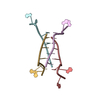
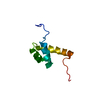
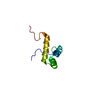
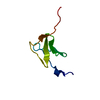
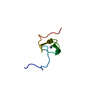
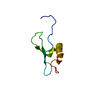

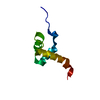
 PDBj
PDBj HSQC
HSQC